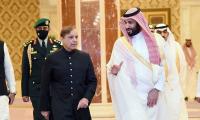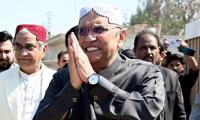The idea of a ‘parliamentary democracy’ is that the legislature be truly representative of the people. If political power remains under absolute control of a limited group (usually ‘owners’ of political parties) instead of with parliament, and only party leaders take policy decisions, appoint government officials and virtually govern the country, then the system is clearly flawed.
No doubt similarities exist between such a situation and democracy in Pakistan, which is why it would not be wrong to suggest that Pakistan’s parliamentary system is in reality an oligarchy.
It is also probably one of the reasons why, despite many elections under the 1973 constitution and chances to rectify and redress, even today we stand at the same point as before. Corruption and bad governance are rampant, the country’s finances are constrained, the concept of separation of powers is unclear, establishment of rule of law is still a distant dream and the judicial system appears to be near collapse. The uncertainty does not seem to have gone away even after the 2018 elections which have thrown up a new force – the PTI.
Political pundits put the blame for all this on our political system and prescribe that the only solution is to adopt a ‘presidential form’, similar to one in the US, in which the president is elected directly through adult franchise. The proponents of this point out that the president (executive) is not accountable to parliament nor bound to appoint his cabinet from amongst members of parliament; instead the president can assemble a ‘cabinet of talent’. The accomplishment of the system is eulogised by the development of the ‘superpower’, which is the US.
To me the mere success of a system in one country is no proof that it will produce the same results in another. Each country has its own peculiar history and social order. France, Germany, Japan and Switzerland are all developed countries in their own way, yet have different forms to the one in the US. If a person like Trump can be elected, it proves that there is no guarantee that the presidential form of government is always the best. Another example is the unprecedented success of China.
The solution is not to adopt alternates only because one system is rotten but as Kahlil Jibran said “Those who want to build a new building should find out the causes of collapse of the first.”
Pakistan’s history shows that one common reason why each time the various systems with which Pakistan has experimented have collapsed is that the government has failed to fulfil its promises with the result that people become disillusioned.
Take the example of the 1956 constitution, which was abrogated in only a couple of years because members of parliament went berserk and ignoring the people of Pakistan, and preferred their own interests over national ones. The 1962 constitution was a form of ‘basic democracy’, and although during this time Pakistan flourished, yet the people were not given any say or ownership in governance, and the system failed.
The PPP formed the first government under the 1973 constitution but failed to deliver on its agenda and on the half-baked socialism through which government took over big and small industries and handed them over to cronies rather than professionals, which brought in massive corruption, and disappointed the people. Only the charisma of ZA Bhutto sustained his government but all this also collapsed when some opposition parties joined with General Zia and imposed martial law in 1977.
The 1973 constitution was restored in a varied form in 1988 but elections under it were held on a non-party basis. Junejo’s government was doomed from the start and soon dismissed. Even the Supreme Court did not restore it.
A hybrid form of the parliamentary system, in which power in the shape of Article 58(2)(b) was given to the president to dissolve the assemblies, was then tried. This led to three dismissals – Benazir Bhutto (1990), Nawaz Sharif (1993) and again Benazir Bhutto (1996). The reason for these dissolutions was almost the same: allegations of corruption, bad governance, nepotism, despotic attitude, massive wasteful spending on mega projects instead of looking after the welfare of the people.
The fourth time Nawaz Sharif was ousted by General Musharraf. After Musharraf, since 1999, three more elections have taken place. And today the previous president, three ex-prime ministers or their families are facing investigations, cases or have been convicted.
The causes of failure in my view are not the ‘parliamentary system’ but the people who form its part. This is why there is no guarantee that a presidential system will work any differently.
In fact those who advocate ‘change’ forget that in the context of Pakistan the presidential system simply cannot work. The major reasons for this are: first, the election of the president nationwide on adult franchise will, rightly so, be resisted by smaller provinces on the ground that each time Punjab will be able to elect a president of its choice. This will stoke bias and separatist feelings. Secondly, a centralised federation would be unacceptable to the Senate and other provincial assemblies as well. Third, once the boat is rocked, influential groups will stress for a completely different system – the Shariah – and this will give them an opportunity to hold countrywide protests/sit-ins.
Fourth, the presidential system works better when there is a two-party system. Pakistan has more regional parties than national parties and cannot go to this system now. And, finally, if we introduce the presidential system, the politics of opposition for the sake of opposition, which has become our culture, will not let it work. Whenever the president would propose a plan, the legislature would reject it thereby causing a deadlock. On the contrary, in a parliamentary system the majority party in the National Assembly can pass the budget. Similarly, an aggrieved president will use his veto rights as retaliation thus delaying the implementation of law.
The only solution is to fill the cracks in the existing parliamentary system. The ills can be cured by a few constitutional amendments. Some suggestions are:
First, more power to the prime minister (for example, authority to select certain percentage of cabinet members from outside parliament). At the same time, the president should be granted some powers as were provided in the 1956 constitution to ensure check and balance.
Second, for parliamentary democracy to work, ambiguous provisions like Article 62(1)(b) under which a parliamentarian can be removed by the courts on the vague grounds that he is not sadiq or amin and such like provisions should be deleted. Parliament cannot flourish if it is controlled through these provisions.
Third, the power given to the president of the party under Article 63(a) to direct members to vote on a constitutional amendment under his/her directions should be omitted as voting on the constitution has to be on the basis of the conscience of members.
Fourth, more than four provinces will suit the parliamentary system, and the procedure for creating new provinces should be made easier. In India, for example, a new province can be carved out through simple majority in the National Assembly only on the condition to consult the effected province.
Fifth, political parties which do not get minimum number of votes such as five percent or more will not get a seat in the National Assembly. This will help to gradually create a system in the country that has fewer parties.
The writer is a Supreme Courtadvocate, former caretakerfederal minister, and former president of the SCBA.
Email: ali@mandviwallaandzafar.com
Any progressive society or government will uphold security so that people can utilize their full potential
In Pakistan, we have witnessed erosion of public trust in government institutions
Capability, accountability, and responsiveness don’t quite capture the increasingly important issue of legitimacy
The government can directly influence economic activity through current and capital expenditure
A view of the Supreme Court of Pakistan. — Supreme Court website/FileWhat kind of firewall does the judiciary...
Indian soldiers stand alongside a barbed wire on the Line of Control. — AFP/FileAnti-Pakistan propaganda remains a...







